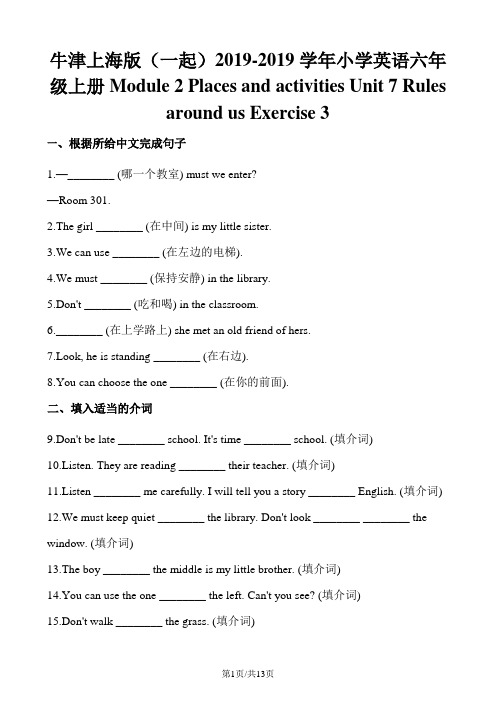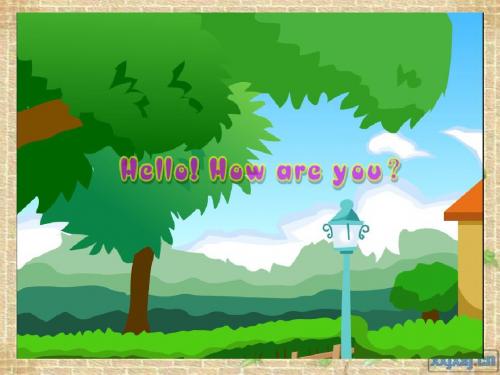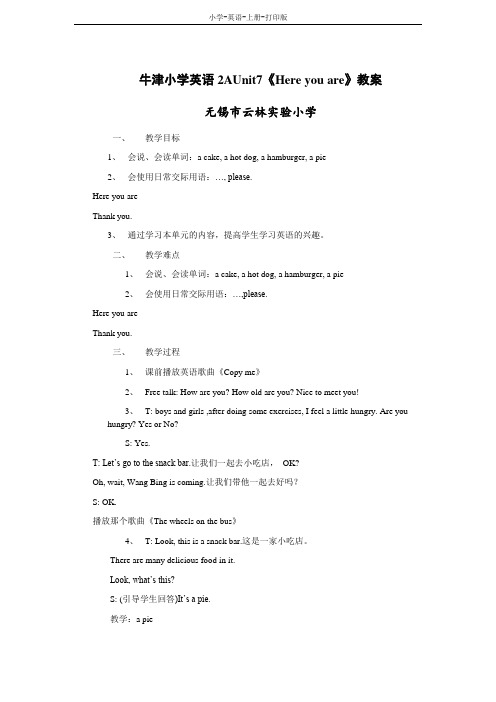牛津小学英语2a Unit7
- 格式:ppt
- 大小:270.50 KB
- 文档页数:15

牛津上海版(一起)2019-2019学年小学英语六年级上册Module 2 Places and activities Unit 7 Rulesaround us Exercise 3一、根据所给中文完成句子1.—________ (哪一个教室) must we enter?—Room 301.2.The girl ________ (在中间) is my little sister.3.We can use ________ (在左边的电梯).4.We must ________ (保持安静) in the library.5.Don't ________ (吃和喝) in the classroom.6.________ (在上学路上) she met an old friend of hers.7.Look, he is standing ________ (在右边).8.You can choose the one ________ (在你的前面).二、填入适当的介词9.Don't be late ________ school. It's time ________ school. (填介词)10.Listen. They are reading ________ their teacher. (填介词)11.Listen ________ me carefully. I will tell you a story ________ English. (填介词)12.We must keep quiet ________ the library. Don't look ________ ________ the window. (填介词)13.The boy ________ the middle is my little brother. (填介词)14.You can use the one ________ the left. Can't you see? (填介词)15.Don't walk ________ the grass. (填介词)三、选出最恰当的答案16.Look at the photo of my father and ________.A. theyB. themC. weD. she17.I'd like to be a teacher because I can ________ children.A. teachB. haveC. makeD. do18.He enjoys ________ very much.A. cookingB. cookC. to be acook D. cooks19.There aren't any trees ________ flowers in the garden.A. orB. andC. soD. but20.He looked ________ at us and then shouted at us.A. angryB. angrilyC. sadD. happy21.I enjoy watching football matches ________ hate volleyball matches.A.andB.butC.soD.like四、根据要求改写句子22.I would like to be a teacher because I want to teach children. (对划线部分提问)________ do you want to be a teacher?23.My father is a teacher. (对划线部分提问)________ ________ ________ your father do?24.You must not walk on the grass. (保持原句意思)________ ________ on the grass.25.There are a lot of books on the shelf. (改为否定句)There are ________________ books on the shelf.26.What is your father?(保持句意不变)________ ________ ________ your father do?27.Sam does her homework at home. (改为否定句)Sam ________ ________ her homework at home.28.I have got a personal computer. (改为一般疑问句)________ you ________ a personal computer?29.I want to teach children. (保持句意不变)I ________ ________ to ________________ ________.五、阅读理解30.阅读短文,作出判断。

Unit 7 Weather1st periodI、Teaching Contents:Let's actII、Teaching Aims:Using imperatives to give simple instructionsAsk and answer about timeIII、Main points and difficult points:1.Locate specific information in response to simple instructionse the patterns “Listen to ・・・ Look at../'in oral practiceIV、Materials:Student's Book2Apage 32Cassette2Aand a cassette playerV、Teaching Procedures:Step 1 Pre-task preparation1.Do a matching exercise by putting up six word cards from the previous three units in a vertical colu mn on thewhiteboard with their corresponding pictures in a column across from them but in a differe nt order. Ask students to come up and connecl them with lines・2.Show a picture of a winter scene where snow is falling. Ask students if they have ever seen snow・3.Enjoy a song: Tick tock time Show the topic: timeElicit: A clock tells the time.e a model clock to practice asking and answering: what time is it? IFs •…(整点)5.Make a chant: Tick, tock, tick, tock, listen to the clock・1,2, 3, 4, look at the clock.What time is it? What time is it?It's time to get up. (It's ・・・ o'clock)Step 2 While-task procedure1.Pair work: ask and answer2.Enjoy a story: What time is it?3.Repeat the story・ Retell the story.4.Play the cassette tape・ Students listen and follow in their books・5.Play the cassette tape again. Students listen and repeat several times・6.Select groups to act the model dialogue for the class・ Before performing the role-play, each student m ay introducehis character.Step 3 Post-task activityTeach some useful classroom language using the expressions students have learned・Read a passage. Then say about myself.Step4 Assignment1.Follow the flash story and retell to your parents.2.Talk about My day2nd periodI、Teaching Contents:Let's talkII、Teaching Aims:1.Asking yes/no questions to obtain simple responses・ing imperatives to give simple instructionsIII、Main points and difficult points:Use modelled phrases to communicate with other learnersIV、Materials: PPT, etcV、Teaching Procedures:Step 1 Pre-task preparation1.Show students some snowflake patterns・ Have one cut out before class・ Put it in front of your mouth andblow, saying Look at the snow. Listen to the wind. Have studen(s copy you.2.Daily report: day, weather, ect3.Elicit: Winter is coming ・ Raise questions about win ter: What do you see? What do you like to do?4.Elicit: snow, snowman, snowball, ice, window flower5.Make a snowman by gluing three white cotton balls in a column on a sheet of blue constructions pa per. Glue ona cut-out of a black hat and a red scarf. Add dots on with white chalk to represent sno w. Point to the snowmanand say This is a snowman. Repeat snowman for students to follow.6.Elicit: Do you like winter? Answer: Yes, I do. No, I don't.Step 2 While-task procedure1.Put up the wallchart for page 33 and ask students to look at it for a short time. Take down the wall cha4rt and askstudents to name some of the things they saw.2.Put-up the wallchart again. Point at the scene and say It is winter. Repeat winter. Shiver and say Fm cold.Repeat cold several times・ Students repeat after you.3.Hold up a puppet and say Are you cold? The puppet shivers and says Yes, Fm cold・ Then ask the p uppet Doyou like winter? The puppet replies No, I don^t・4.Play the cassette tape for students to listen to the correct pronunciation. Student follow in their books.5.Divide the class into pairs・ Students practice acting the dialogue・ Select pairs to act the model dialog ue inclass・6.Relaxing time: Sing a song: Little Snowman7・Show other seasons and talk about like or dislike: Do a survey in pairs・8. Make a chaWinter, winter, do you like winter? Yes, yes, yes, I do.Summer, summer, do you like summer? No, no, no, I don't.1.Put up picture cards of some food items on the board・ Have the same pairs practice making new dial ogues bysubstituting snow and snowman with different food items・ Tell the reasons if they can.2.Invite a number of groups to act their dialogues to the class・Step 4 Assignment: Learn a flash story…Snowman3nl periodI、Teaching Contents:Let's learnII、Teaching Aims:ing nouns to identify clothinging adjectives to express how you feeling nouns to identify season and weatherIII、Main points and difficult points:ing nouns to identify clothing2.Pronounce words properlyIV、Materials: PPT, a puppetV、Teaching Procedures:Step 1 Pre-task preparation1.Sing a song: Little Snowman2.Daily report: Talk about winter3.Check the homework: retell the flash story…Winter4.Hold up a puppet and say You are cold. You must wear a ha(・ Put a hat on the puppet. It says Tha nk you.Continue putting toy clothing on the puppet until it has a hat, a pair of gloves and a scarf o n.5.Point to the hat, the gloves and the scarf on the puppet and say the words・ Repeat for students to fo How.Step 2 While-task procedure1.Put the vocabulary picture cards on your desk・ Say the words and invite individual students to come up and pickout the right card.2.Put up the picture card for hats on the board, and put the word card next to it. Read the word sever al times andask the students to repeat. Do the same with the other 6 new words.3.Open the Student's Book to page 34. Play the cassette tape・ Ask the students to point to the relevant picturesand repeat the words・4.Put up the picture and word cards on the board in a random order. Ask individual students to come up andrearrange them by putting the word card below their corresponding picture cards, as shown in t heir Student's Books・5.CAI: show many clothes and ask Ss to talk about like or dislike and tell the reason.1.Draw the outline of Sam on the board・ Put the picture cards for the clothing vocabulary items on the table.Have individual students come up and put the clothing items on Sam with magnets・ Then stick thecorresponding words next to the picture cards.2.Play a game: Clothes game and learn more clothing words.Step 4 Assignment:Learn a flash story■一Winter4th periodI、Teaching Contents:Let's play & Let's enjoyII、Teaching Aims:ing adjectives to express how people feeling nouns to refer to facial featuresIII、Main points and difficult points:1. Maintain an interaction by providing informationIV > Materials: PPTV、Teaching Procedures:Step 1 Pre-task preparation1.Draw a snowman with a big hat on the board・ Write several lists of six words each・ Tell students th at ifanyone can read any of the lists, you will write his name on the hat!2.Revise the words face and nose by showing students the word cards and asking them to read the wor ds.Step 2 While-task procedure1.Hole up a puppet and the puppet begins to say the rhyme slowly.2.Say Lei's listen to the rhyme again・ We will make the sounds and do the actions, too.3.Play the cassette tape for the class to listen to and encourage them to make the sounds and d o the actions.4.Play the cassette tape again, pausing at each line until students are familiar with the rhyme.e the cassette tape again, this time letting students read and follow the rhyme on Students B ook page 35, miming the actions at the some time・6.For the better Ss: Make a long rhymeThe wind blows on my face. My face is cold.The wind blows on my nose・ My nose is cold.(My ears / feet/ toes are ...)Step 3 Post-task activities1.Ask individuals or groups of students to perform the rhyme in front of the class・2.Play a guessing game・ Say 1 will do an action and you must try to guess the word it refers to. Mim e actionssuch as wind blowing, snowing, or shivering・3.Continue the guessing game but ask individual students to do the actions for the class to guess・Step4 AssignmentRead a passage: Winter。

一、主要新授内容(new contents)Let’s talk---Do you like…? Yes, I do. No, I don’t.二、学习目标(Objectives)1、结合生活实际中winter这个语言环境,用What can you see/wear/do? 来复习前几个教时中所学过的单词。
2、能熟练掌握句型Do you like…? Yes, I do. No, I don’t.并能结合学生已有的一些名词进行操练。
3、能运用已学句型做调查,进行自由交际,灵活运用。
三、教学建议1、任务前期准备阶段(Pre-task preparation section)Pre-task Preparation是指我们要求学生运用目的语(即所学的语言)之前,呈现给学生的新语言材料。
也就是我们常说的:Input。
在这个环节主要让学生获得对新语言材料的第一次感知。
Activity 1 (Letters)1、教学辅助(Aids)字母卡片2.活动过程(Process)Activity 2 Rhyme1、教学辅助(Aids)1)电脑(2A-U7-P3-3)(2A-U7-P3-4)2)屏幕2.活动过程(Process)Activity 3 (Ask and answer)1、教学辅助(Aids)1)电脑(2A-U7-P4-1)2)屏幕2.活动过程(Process)2、任务中期实施阶段(While-task procedure section)While-task Procedure,这是指语言技能的习得过程。
其中分为机械性操练和意义性操练两部分。
机械性操练可以让学生准确地模仿、复说新授的语言,让他们经过从模仿到识记的过程,使新知识由感知、理解、模仿直到储存。
在这个教学阶段也可以设计新授知识的二次或多次导入,并根据语言训练的需要设计相应的机械性操练和意义性操练。
在这种情况下,建议每项Activity形式尽可能不同,时间不要长,一个活动紧接着一个活动,容易抓住学生的注意力,维持学习兴趣。

牛津上海版(试用本)英语六年级上册 Module2 Places and activities Unit 7 Rules around us Exercise4练习卷一、根据字母/中文提示完成单词1. 根据所给音标,完成句子1. The boys are ________/'krɒzɪŋ/the road.2. The girl is looking left, then ________/raɪt/.3. The children are playing on the zebra ________/'krɒzɪŋ/.4. This is the ________/wel/we cross the road.5. You can ________/pɑːk/your car here.6. Grandma is walking ________/ə'kɒs/the road quickly.7. Mark and Eddie are running ________/ɒn/the pavement.8. ________/dəʊnt/play football in the street. It's dangerous.9. The bus________/'draɪvə/can't drive a bus here。
二、单选题Don't ________ your car here. ()A.parkingB.stoppingC.stopsD.parkI met my uncle ________ home. ()A.on my way toB.on my way goC.on this way toD.on my way三、选择正确图片/词句You can ________ the road now. ()A.walk crossB.walk acrossC.crossesD.crossing四、单选题________ that right or wrong? ()A.DoesB.DoC.AreD.Is五、选择正确图片/词句You'd better ________ left. ()A.turnB.turningC.turnsD.to turnLook, the boy is looking left, ________ right. ()A.andB.orC.butD.thenDon't eat ________ ice cream. ()A.so manyB.too muchC.manyD.several________ be late again. ()A.NotB.Doesn'tC.Don'tD.Aren't六、对划线部分提问根据要求改写句子1. You have to book the ticket. (改为否定句)________________2. We can find signs everywhere in the world. (对划线部分提问)________________3. We can cross the road here.(改为否定句)________________4. You can see the escalator in the middle. (对划线部分提问)________________5. I'd like strawberries. (保持原句意思)I ________ ________.七、阅读选择阅读短文,选出正确的答案Helen has four brothers and sisters. They are Jenny, Peter, Bill and Anna. Helen is the oldest of them. Jenny is thirteen years old. She is two years younger than Helen, and one year older than Peter. Bill is nine and Anna is seven years old. Jenny and Peter are good runners. But Peter can run faster. Helen and Anna like to play basketball after school. Helen plays better than Anna. Bill is the best singer of the five. Helen and Betty study in a middle school. Peter, Bill and Anna study in an elementary school. They all work hard at their lessons. They help each one another(互相) and they love one another.(1)How old is Helen? ( )A.ElevenB.FifteenC.TwelveD.fourteen(2)Who play basketball better than Anna? ( )A.AnnB.HelenC.JennyD.Peter(3)Who runs fastest of the five? ( )A.JennyB.PeteC.Jenny and PeterD.All of them(4)Who can sing best? ( )A.AnnB.HelenC.PeterD.Bill八、其他作文写作We have rules in our school参考答案与试题解析牛津上海版(试用本)英语六年级上册 Module2 Places and activities Unit 7 Rules around us Exercise4练习卷一、根据字母/中文提示完成单词1.【答案】1. crossing,2. right,B. crossing,4. way,5. park,6. across,7. on,8. Don't,9. driver【考点】副词形容词介词名词Places and activities: What would you like to be?【解析】此题暂无解析【解答】1. 句意:那些男孩们……马路。


牛津小学英语2AUnit7《Here you are》教案无锡市云林实验小学一、教学目标1、会说、会读单词:a cake, a hot dog, a hamburger, a pie2、会使用日常交际用语:…, please.Here you areThank you.3、通过学习本单元的内容,提高学生学习英语的兴趣。
二、教学难点1、会说、会读单词:a cake, a hot dog, a hamburger, a pie2、会使用日常交际用语:…,please.Here you areThank you.三、教学过程1、课前播放英语歌曲《Copy me》2、Free talk: How are you? How old are you? Nice to meet you!3、T: boys and girls ,after doing some exercises, I feel a little hungry. Are youhungry? Yes or No?S: Yes.T: Let’s go to the snack bar.让我们一起去小吃店,OK?Oh, wait, Wang Bing is coming.让我们带他一起去好吗?S: OK.播放那个歌曲《The wheels on the bus》4、T: Look, this is a snack bar.这是一家小吃店。
There are many delicious food in it.Look, what’s this?S: (引导学生回答)It’s a pie.教学:a pieT: What’s that?S: (引导学生回答)It’s a hamburger.教学:a hamburgerT: Is this a hamburger?S: No, it isn’t.(引导学生回答) It’s a hot dog.教学:a hot dogT: Next, let’s look,让我们看一下动画里的熊妈妈是不是在做hot dog。
课题:Unit1My family教案内容:☆教学调整☆教学目标:1、能听懂、会说、会认单词father、mother、brother、sister、me2、能用This is my …来介绍自己的家庭成员。
教学重点目标1、2教学准备:手指套、全家福照片、图片、一副眼镜、领带教学时间:三课时教学过程:第一课时一、warm up1、greetingT: Good morning.How are you?2、listen and do. Raise your hand. Wave your hand. Put itdown.二、presentationT show the family photo: now, boys and girls, look,what isthis? This is my family photo. Look, my father, my motherand me . This is my family.用手圈一下。
教my family.由慢到快。
Ss read one by oneSs say : my family, your family.(出示他们的照片)(一)teach: father, mother, me(1)老师出示自己的全家照自问自答:look, guess who is he?S: Father. (给予学生适当的奖励)T: Yes. This is my father。
T show the card :father 贴于Bb, 领读几遍,注意th 的发音。
Ss read : father,father ,my father (一小组传卡片挨个读; 一组一组读,)T : look, this is my father. 出示句型卡片This is my ……学生跟读遍。
T:Who can follow me ?introduce your father学生手指着照片练说。
Unit 7 At the beach单元教学设计课题:小学英语上海牛津版五年级上学期Unit 7 At the beach单元教学设计一、学情分析经过四年半的学习,五年级的学生已经积累了一定较为丰富的词汇、句型知识,具备了日常听说读写的一些基本技能,喜欢将自己的所见所闻与人分享交流,他们在课堂上的发言或展演越来越自然得体,初步形成了自主学习的良好习惯。
但如何得体地用英语表达自己的情感,或完整描述一个故事、场景等,仍然存在行文不畅,逻辑不顺,时态语法不对等问题。
因此,教师应该加强这方面的指导和帮助。
At the beach这个话题对于生活在海边的深圳孩子来说是比较熟悉的,他们大多参加过各类沙滩活动,学生的主要困难在于不知如何用英语表达相应的专业术语,对于现在进行时的用法仍然比较生疏。
在这之前,同学们已经学习过相关Activities,Places,Hobbies。
一、教材分析本课选取的是牛津英语小学五年级上册Module 3中的Unit 7 At the beach。
Module 3的主题是Out and about,该主题是五年级新的主题,但是却和Book 1A, Book 2A, Book 3A, Book 4A的Module 3 Places and activities 密切相关,这四册书的第三模块都在介绍地点和活动,让学生充分理解有关地点的单词,比如forest, farm, playground, park, zoo等等,并且熟练运用相关句型。
在此基础之上,拓展了本单元的主题At the beach, 可以说本单元是承上启下的作用,既延续了前面的知识点,又为接下来Unit8 An outing 和Unit 9 Around the city做了铺垫。
单元教材由Listen and say Look and learn Say and act Listen and enjoy Learn the sounds组成,以对话、故事、歌谣等形式呈现。